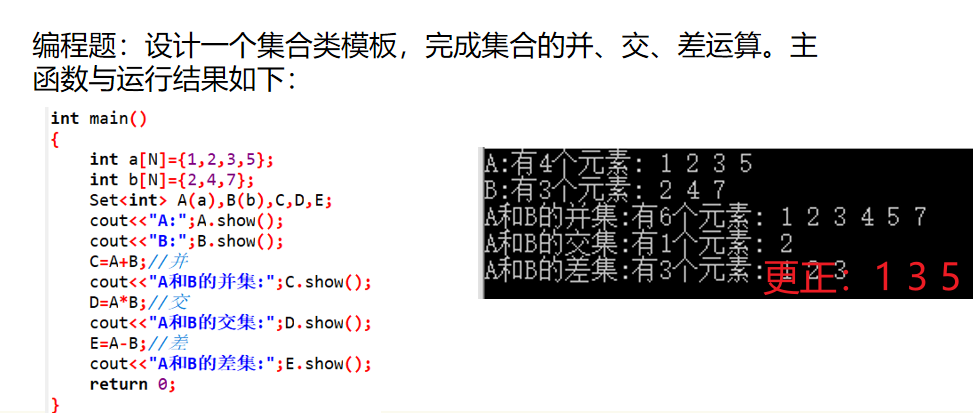1
2
3
4
5
6
7
8
9
10
11
12
13
14
15
16
17
18
19
20
21
22
23
24
25
26
27
28
29
30
31
32
33
34
35
36
37
38
39
40
41
42
43
44
45
46
47
48
49
50
51
52
53
54
55
56
57
58
59
60
61
62
63
64
65
66
67
68
69
70
71
72
73
74
75
76
77
78
79
80
81
82
83
84
85
86
87
88
89
90
91
92
93
94
95
96
97
98
99
100
101
| #include <cstdio>
#include <iostream>
#include <cstring>
using namespace std;
const int N = 15;
template<typename T>
class Set {
public:
Set() {
t[N] = {0};
size = 0;
}
Set(T num[N]) {
memcpy(t, num, sizeof(T) * N);
size = 0;
for (int i = 0; i < N; i++, size++) {
if (t[i] == 0) break;
}
}
void show() {
printf("有%d个元素:", size);
for (int i = 0; i < size; i++) cout << t[i] << ' ';
puts("");
}
Set operator+(Set &s);
Set operator-(Set &s);
Set operator*(Set &s);
private:
T t[N];
int size;
};
template<typename T>
Set<T> Set<T>::operator+(Set<T> &s) {
Set<T> temp;
memcpy(temp.t, t, sizeof(T) * size);
int k = size;
for (int i = 0; i < s.size; i++) {
bool flag = false;
for (int j = 0; j < size; j++) {
if (s.t[i] == temp.t[j]) {
flag = true;
break;
}
}
if (flag == false) temp.t[k++] = s.t[i];
}
temp.size = k;
return temp;
}
template<typename T>
Set<T> Set<T>::operator-(Set<T> &s) {
Set<T> temp;
int k = 0;
for (int i = 0; i < size; i++) {
bool flag = false;
for (int j = 0; j < s.size; j++) {
if (t[i] == s.t[j]) {
flag = true;
break;
}
}
if (flag == false) temp.t[k++] = t[i];
}
temp.size = k;
return temp;
}
template<typename T>
Set<T> Set<T>::operator*(Set<T> &s) {
Set<T> temp;
int k = 0;
for (int i = 0; i < size; i++)
for (int j = 0; j < s.size; j++) {
if (t[i] == s.t[j]) temp.t[k++] = s.t[j];
}
temp.size = k;
return temp;
}
int main() {
int a[N] = {1, 2, 3, 5};
int b[N] = {2, 4, 7};
Set<int> A(a), B(b), C, D, E;
cout << "A:";
A.show();
cout << "B:";
B.show();
C = A + B;
cout << "A和B的并集:";
C.show();
D = A * B;
cout << "A和B的交集:";
D.show();
E = A - B;
cout << "A和B的差集:";
E.show();
return 0;
}
|





